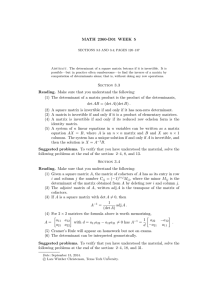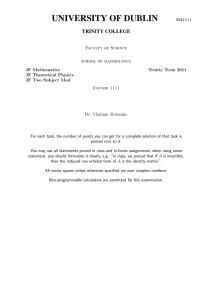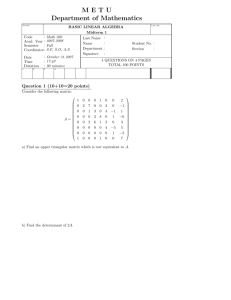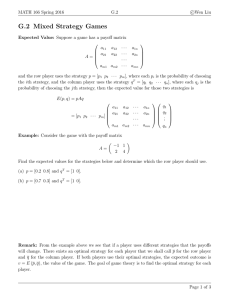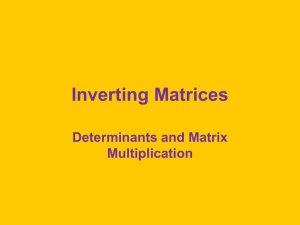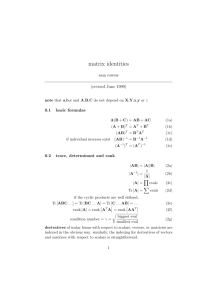MATH 304 Linear Algebra Lecture 8: Elementary matrices.
advertisement
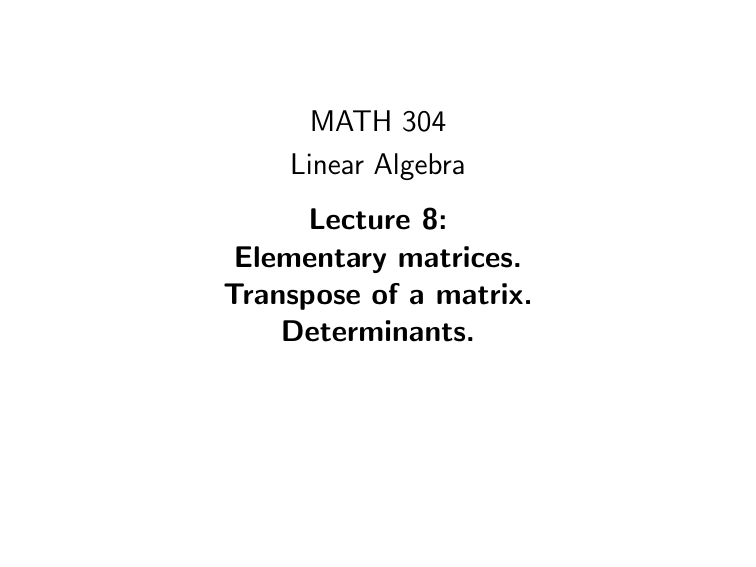
MATH 304 Linear Algebra Lecture 8: Elementary matrices. Transpose of a matrix. Determinants. General results on inverse matrices Theorem 1 Given an n×n matrix A, the following conditions are equivalent: (i) A is invertible; (ii) x = 0 is the only solution of the matrix equation Ax = 0; (iii) the matrix equation Ax = b has a unique solution for any n-dimensional column vector b; (iv) the row echelon form of A has no zero rows; (v) the reduced row echelon form of A is the identity matrix. Theorem 2 Suppose that a sequence of elementary row operations converts a matrix A into the identity matrix. Then the same sequence of operations converts the identity matrix into the inverse matrix A−1 . Row echelon form of a square matrix: ∗ ∗ ∗ ∗ ∗ ∗ ∗ ∗ ∗ ∗ ∗ ∗ ∗ ∗ ∗ ∗ ∗ ∗ ∗ ∗ ∗ invertible case ∗ ∗ ∗ ∗ ∗ ∗ ∗ ∗ ∗ ∗ ∗ ∗ ∗ ∗ ∗ ∗ ∗ ∗ noninvertible case For any matrix in row echelon form, the number of columns with leading entries equals the number of rows with leading entries. For a square matrix, also the number of columns without leading entries (i.e., the number of free variables in a related system of linear equations) equals the number of rows without leading entries (i.e., zero rows). Row echelon form of a square matrix: ∗ ∗ ∗ ∗ ∗ ∗ ∗ ∗ ∗ ∗ ∗ ∗ ∗ ∗ ∗ ∗ ∗ ∗ ∗ ∗ ∗ invertible case ∗ ∗ ∗ ∗ ∗ ∗ ∗ ∗ ∗ ∗ ∗ ∗ ∗ ∗ ∗ ∗ ∗ ∗ noninvertible case Hence the row echelon form of a square matrix A is either strict triangular or else it has a zero row. In the former case, the equation Ax = b always has a unique solution. In the latter case, Ax = b never has a unique solution. Also, in the former case the reduced row echelon form of A is I . Why does it work? a1 a2 1 0 0 a1 a2 a3 0 2 0 b1 b2 b3 = 2b1 2b2 c1 c2 c1 c2 c3 0 0 1 1 0 0 a1 a2 a3 a1 a2 3 1 0b1 b2 b3 =b1+3a1 b2+3a2 c1 c2 0 0 1 c1 c2 c3 a1 a2 1 0 0 a1 a2 a3 0 0 1 b1 b2 b3 = c1 c2 b1 b2 c1 c2 c3 0 1 0 a3 2b3 , c3 a3 b3+3a3 , c3 a3 c3 . b3 Proposition Any elementary row operation can be simulated as left multiplication by a certain matrix. Elementary matrices E = 1 ... O 1 r 1 O ... 1 row #i To obtain the matrix EA from A, multiply the i th row by r . To obtain the matrix AE from A, multiply the i th column by r . Elementary matrices 1 ... 0 E = ... 0 ... 0 ... O ··· 1 .. . . . . ··· r ··· 1 .. . . . .. . . ··· 0 ··· 0 ··· 1 row #i row #j To obtain the matrix EA from A, add r times the i th row to the jth row. To obtain the matrix AE from A, add r times the jth column to the i th column. Elementary matrices E = 1 ... 0 ··· 1 .. . . . .. . . 1 ··· 0 O O ... 1 row #i row #j To obtain the matrix EA from A, interchange the i th row with the jth row. To obtain AE from A, interchange the i th column with the jth column. Why does it work? (continued) Assume that a square matrix A can be converted to the identity matrix by a sequence of elementary row operations. Then Ek Ek−1 . . . E2E1 A = I , where E1 , E2, . . . , Ek are elementary matrices simulating those operations. Applying the same sequence of operations to the identity matrix, we obtain the matrix B = Ek Ek−1 . . . E2E1I = Ek Ek−1 . . . E2E1 . Thus BA = I . Besides, B is invertible since elementary matrices are invertible. It follows that A = B −1, then B = A−1 . Transpose of a matrix Definition. Given a matrix A, the transpose of A, denoted AT , is the matrix whose rows are columns of A (and whose columns are rows of A). That is, if A = (aij ) then AT = (bij ), where bij = aji . T 1 4 1 2 3 = 2 5 , Examples. 4 5 6 3 6 T T 7 4 7 4 7 8 = (7, 8, 9), = . 7 0 7 0 9 Properties of transposes: • (AT )T = A • (A + B)T = AT + B T • (rA)T = rAT • (AB)T = B T AT • (A1 A2 . . . Ak )T = ATk . . . AT2 AT1 • (A−1)T = (AT )−1 Definition. A square matrix A is said to be symmetric if AT = A. For example, any diagonal matrix is symmetric. Proposition For any square matrix A the matrices B = AAT and C = A + AT are symmetric. Proof: B T = (AAT )T = (AT )T AT = AAT = B, C T = (A + AT )T = AT + (AT )T = AT + A = C . Determinants Determinant is a scalar assigned to each square matrix. Notation. The determinant of a matrix A = (aij )1≤i,j≤n is denoted det A or a a ... a 1n 11 12 a a ... a 2n 21 22 . .. . . . . . ... . . an1 an2 . . . ann Principal property: det A 6= 0 if and only if a system of linear equations with the coefficient matrix A has a unique solution. Equivalently, det A 6= 0 if and only if the matrix A is invertible. Definition in low dimensions a b = ad − bc, Definition. det (a) = a, c d a11 a12 a13 a21 a22 a23 = a11a22 a33 + a12a23a31 + a13a21a32 − a31 a32 a33 −a a a − a a a − a a a . 13 22 31 +: −: * ∗ ∗ ∗ ∗ * ∗ * ∗ ∗ * ∗ ∗ ∗ ∗ , ∗ * * * ∗ ∗ , * ∗ ∗ * ∗ ∗ * ∗ ∗ 12 21 33 ∗ * , ∗ ∗ ∗ , * 11 23 32 ∗ * ∗ ∗ ∗ * * ∗ ∗ ∗ ∗ * * ∗ . ∗ ∗ * . ∗ Examples: 2×2 matrices 3 0 1 0 0 −4 = − 12, 0 1 = 1, 7 0 −2 5 5 2 = 14, 0 3 = − 6, 0 0 0 −1 4 1 = 0, 1 0 = 1, 2 1 −1 3 8 4 = 0. −1 3 = 0, Examples: 3×3 matrices 3 −2 0 1 0 1 = 3 · 0 · 0 + (−2) · 1 · (−2) + 0 · 1 · 3 − −2 3 0 − 0 · 0 · (−2) − (−2) · 1 · 0 − 3 · 1 · 3 = 4 − 9 = −5, 1 4 6 0 2 5 = 1·2·3+4·5·0+6·0·0− 0 0 3 − 6 · 2 · 0 − 4 · 0 · 3 − 1 · 5 · 0 = 1 · 2 · 3 = 6. Let us try to find a solution of a general system of 2 linear equations in 2 variables: a11 x + a12 y = b1 , a21 x + a22 y = b2 . Solve the 1st equation for x: x = (b1 − a12 y )/a11 . Substitute into the 2nd equation: a21 (b1 − a12 y )/a11 + a22 y = b2 . Solve for y : y = a11 b2 − a21 b1 . a11 a22 − a12 a21 a22 b1 − a12 b2 . a11 a22 − a12 a21 a11 b1 a21 b2 . y = a11 a12 a21 a22 Back substitution: x = (b1 − a12 y )/a11 = Thus b1 b2 x = a11 a21 a12 a22 , a12 a22
